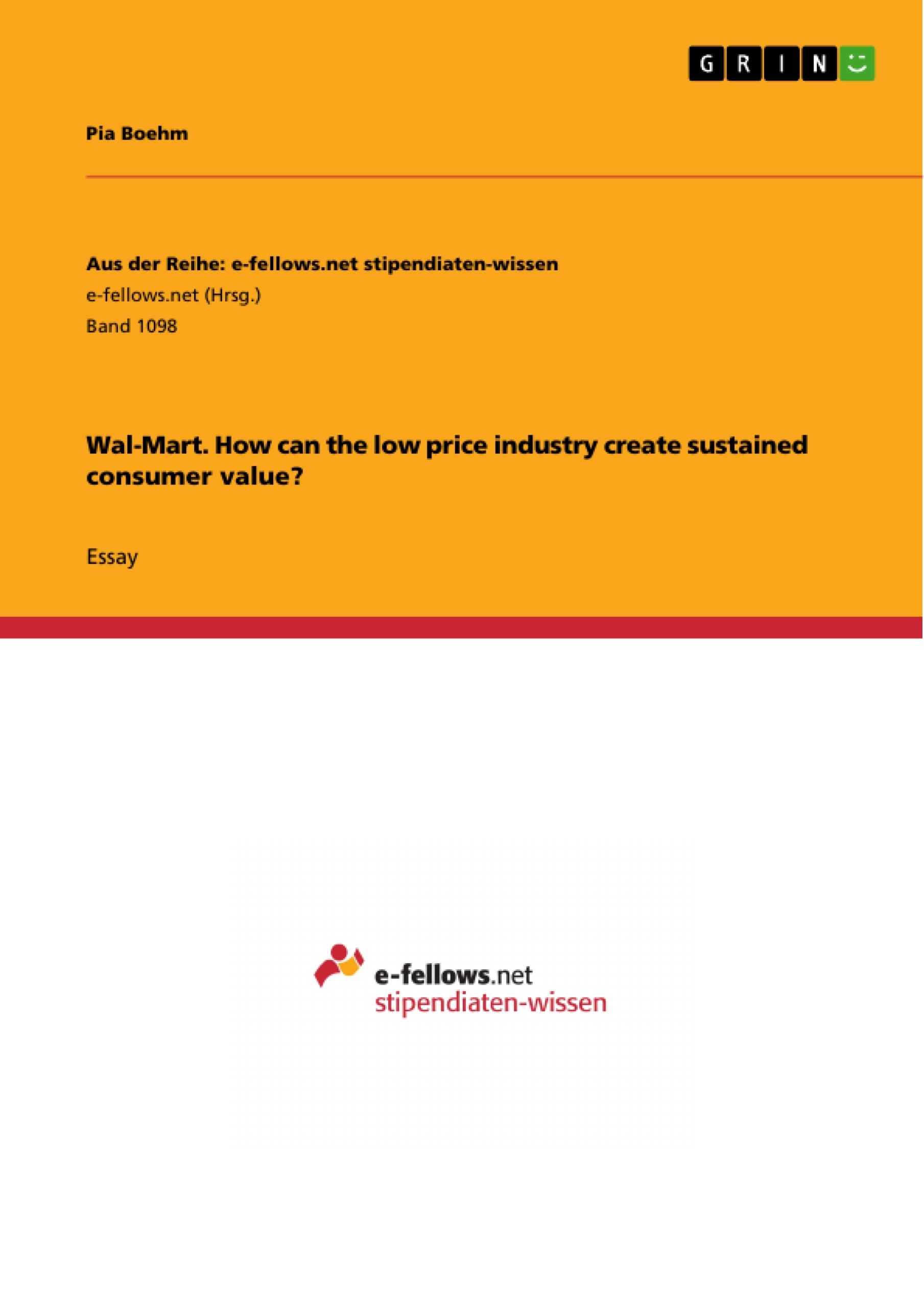“[…] the work we do to help people live better goes far beyond our store walls. It extends into our communities and around the world and affects the lives of people we will never meet.” (Wal-Mart web page, 2014).
Wal-Mart is the world’s largest public corporation, the biggest private employer with over two million employees and also the largest retailer (Fortune, 2014). However, Wal-Mart is a company which has been confronted with many revealing headlines about its poor social sustainability in recent years; for example, employees in the US are significantly underpaid so that they cannot even afford health insurance (Wedekind, 2009). With regard to these facts, this essay is aiming to analyse the following question:
“How can Wal-Mart create customer value in a low price industry in such a way that its customers disregard its lack of social sustainability?”
Inhaltsverzeichnis (Table of Contents)
- Relevance of analysing Wal-Mart's customer value creation in combination with its social sustainability reputation
- Status quo regarding Wal-Mart's social sustainability reputation and its activities for customer value creation
- Managerial recommendations for a strategy to create sustained customer value
- Short-term solutions
- Long-term solutions
- Conclusion
Zielsetzung und Themenschwerpunkte (Objectives and Key Themes)
This essay analyzes Wal-Mart's ability to create customer value while facing criticism for its lack of social sustainability. It investigates how the company can maintain a low-price strategy while addressing its social responsibility concerns.- Customer value creation in a low-price industry
- Social sustainability and its impact on customer perception
- VRIN-resources and dynamic capabilities as strategies for competitive advantage
- Short-term and long-term solutions for improving customer value and social sustainability
- The relationship between social responsibility and customer loyalty
Zusammenfassung der Kapitel (Chapter Summaries)
- Relevance of analysing Wal-Mart's customer value creation in combination with its social sustainability reputation: This section introduces the research question and highlights the importance of analyzing Wal-Mart's customer value creation strategies in conjunction with its social sustainability reputation. It emphasizes the company's size and influence, while acknowledging its controversial history regarding employee treatment and social responsibility.
- Status quo regarding Wal-Mart's social sustainability reputation and its activities for customer value creation: This section explores Wal-Mart's customer value creation strategies, focusing on its low-price approach and customer service initiatives. It also examines the criticisms surrounding the company's social sustainability, including allegations of low wages, unethical practices, and negative impacts on local communities.
- Managerial recommendations for a strategy to create sustained customer value: This section proposes strategies for Wal-Mart to create sustained customer value while addressing its social sustainability concerns. It emphasizes the use of VRIN-resources (valuable, rare, imperfectly imitable, and non-substitutable) and dynamic capabilities (adapting to changing environments) to achieve competitive advantage. Short-term solutions focus on enhancing customer experience through improved store operations, supplier relationships, and e-commerce strategies. Long-term solutions emphasize identifying customer values related to social and environmental issues and aligning Wal-Mart's operations accordingly.
Schlüsselwörter (Keywords)
This analysis focuses on the concepts of customer value creation, social sustainability, VRIN-resources, dynamic capabilities, and competitive advantage. It explores the relationship between social responsibility, customer loyalty, and long-term success within the context of a low-price retail environment. Key terms include: Wal-Mart, customer value, social sustainability, VRIN-resources, dynamic capabilities, competitive advantage, low-price strategy, ethical practices, and employee treatment.- Quote paper
- Pia Boehm (Author), 2014, Wal-Mart. How can the low price industry create sustained consumer value?, Munich, GRIN Verlag, https://www.grin.com/document/287942



